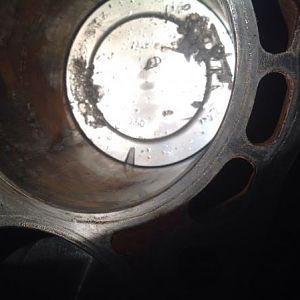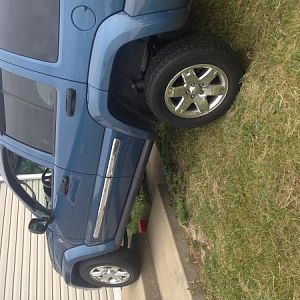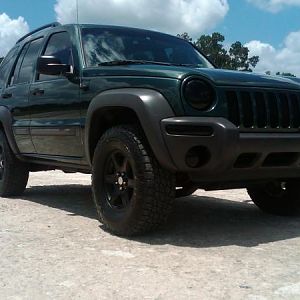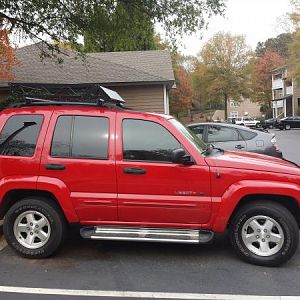What the Liberty could have been (Bob Sheaves)
I am one of those rabid Jeep fans that hates the KJ, for what it is. There was an opportunity to showcase a good independent front suspension (IFS) and the management blew it. If you remember back before it was introduced, I was a supporter of the car, because I knew what Chrysler had on the shelf (from the "King Of The Hill" prototype) and didn't think the management ignorant enough to NOT use it. Unfortunately, I was wrong and the "little girl's car" that debuted was a mess. All it would have cost was another $70 per vehicle (yes, that's a lot, but IMHO, the cost was justified-you don't see new HMMWV's running around under $100K today and the KJ could have had that much mobility).
The one bright spot for me is the Rescue show car-I know from my work on the Dodge Ram 4 link over constrained system, that this vehicle is (again, for me only-I am not telling anyone their ideas are wrong) a ray of hope and lust (amazing what yanks my crank, ain't it?) because of the air springs, long travel, AAM axles, and the possibility of an inexpensive (relatively speaking, of course-for home installation) of a CTIS system. All of this wrapped in a basic (meaning simple construction) body that is free of frilly plastic and junk (obviously, I am discounting the wannabe lamps built into the roof rack-another useless affectation from Design Office).
What many off roaders forget (or never knew) is that Jeep, in 1962, invented the first independent front suspension (IFS) for an off road vehicle in the US [Wagoneer] and offered it as an option.
The suspension Evan Boberg talks about in his book started out as the 1962 Wagoneer suspension-that was the genesis of the improvements...
My disgust with the KJ comes from the half-hearted job done on the IFS. Personally, I don't care what suspension is used, as long as it performs to the intended goals and parameters. In this respect, I have to admit the KJ does well-it was designed as a "girl's Jeep"...people may not like this characterization, but nontheless, it is quite accurate in describing the performance parameters. Jeep had, on the shelf, a design that would make the currect suspension seem as antiquated as the hotchkiss used on the CJ's, when looked from a technical standpoint. Unfortunately, there are only about 20 people in toto that have driven this kind of suspension, and 4 of them are NOT from Chrysler (I built a more advanced version of the KOTH Jeep suspension for a friend of mine under a Chevy full size Blazer (the GMT 400) that had 18" of wheel travel and a stock track width).
Unfortunately also, people that are not suspension engineers tend to be a bit ignorant about the pros and cons of variuous designs, hence the fear (justified in some cases) that the Jeeps will be "screwed up". by people (meaning the design and engineering staff of the controlling company) that have no idea what a Jeep is. These types of people generally cling to some perverse idea that change is bad-I agree with you on the statement, but not the reasoning there. What people need to understand is the the word Jeep, since it's inception, has ONLY meant one thing and one word....
MOBILITY
The history of Jeep has never been centered aroung "change" but rather using the most defined parameters (it started with the military as "everyone knows"- but I would bet any amount of money that not 1 in 10 "experts" can list even 5 of the original military mobility requirements. Jeep has always been a purpose built vehicle-it has ALWAYS hit the intended target. That is not to infer that the targets were acceptable to the marketplace (the FC's and the KJ are 2 different examples of bad targets that were hit and while one failed, the other has been prosperous). Until a good independent suspension is manufactured in the general marketplace and people try it....change will always be viewed as bad.....
Actually, it predates the Kinetic system, which is marketed by Tenneco Automotive now.
The suspension I am describing is one that, in addition to allowing the left and right tire to move independently of each other, allows the axle to move vertically as a percentage of the total wheel travel, the point is to allow the CV joints to be used for turning and power transmission without exceeding the limits of travel. What Evan described in the book (meaning comparing the HMMWV IFS/IRS to a Jeep Link/coil) demonstrates the limits of Rzeppa and tripod joint construction. This all means that a conventional IFS is limited to 8" of vertical travel, in general with a fixed axle, as used on the KJ. With the "floating axle" design this can easilly increase to 12" and more, IF the length of the control arms is optimized.
You can search the US Patent office for "Evan Boberg" and call up the patent and drawings for this design to get an idea how it works.










